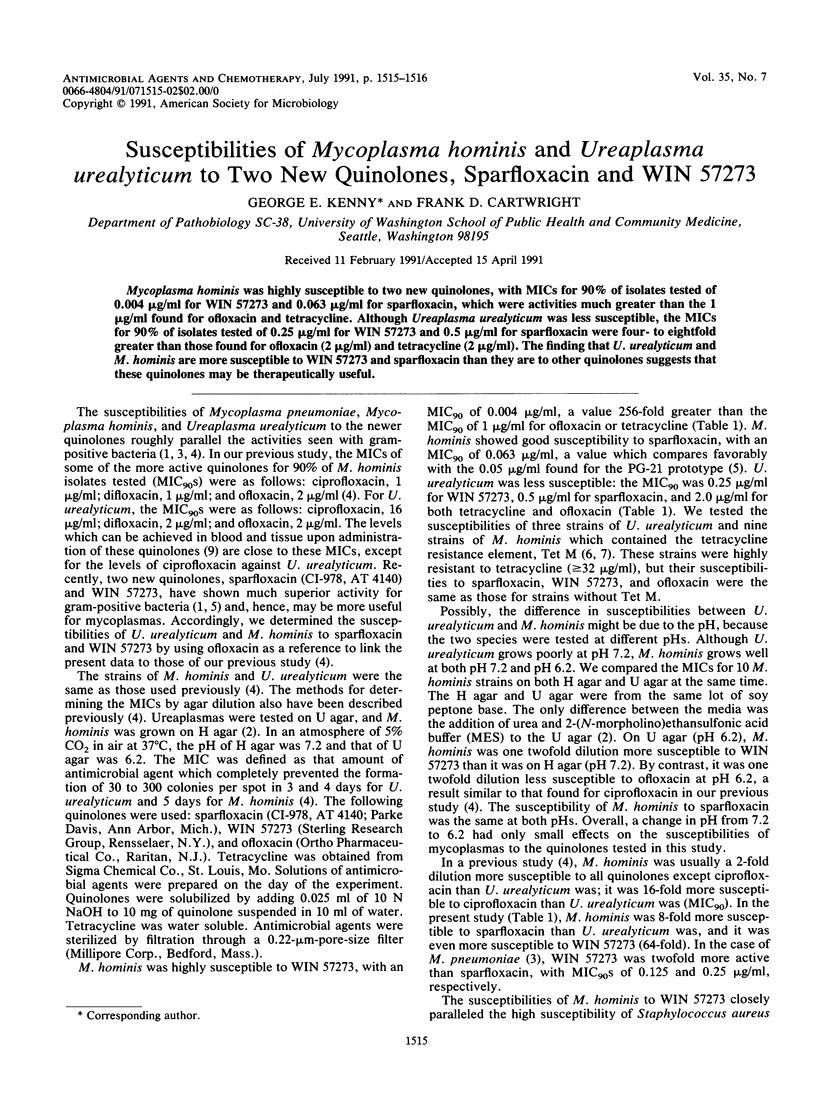Abstract
Mycoplasma hominis was highly susceptible to two new quinolones, with MICs for 90% of isolates tested of 0.004 micrograms/ml for WIN 57273 and 0.063 micrograms/ml for sparfloxacin, which were activities much greater than the 1 microgram/ml found for ofloxacin and tetracycline. Although Ureaplasma urealyticum was less susceptible, the MICs for 90% of isolates tested of 0.25 micrograms/ml for WIN 57273 and 0.5 micrograms/ml for sparfloxacin were four- to eightfold greater than those found for ofloxacin (2 micrograms/ml) and tetracycline (2 micrograms/ml). The finding that U. urealyticum and M. hominis are more susceptible to WIN 57273 and sparfloxacin than they are to other quinolones suggests that these quinolones may be therapeutically useful.
Full text
PDF

Selected References
These references are in PubMed. This may not be the complete list of references from this article.
- Jones R. N., Barry A. L. In vitro evaluation of WIN 57273, a new broad-spectrum fluoroquinolone. Antimicrob Agents Chemother. 1990 Feb;34(2):306–313. doi: 10.1128/aac.34.2.306. [DOI] [PMC free article] [PubMed] [Google Scholar]
- Kenny G. E., Cartwright F. D. Susceptibility of Mycoplasma pneumoniae to several new quinolones, tetracycline, and erythromycin. Antimicrob Agents Chemother. 1991 Mar;35(3):587–589. doi: 10.1128/aac.35.3.587. [DOI] [PMC free article] [PubMed] [Google Scholar]
- Kenny G. E., Hooton T. M., Roberts M. C., Cartwright F. D., Hoyt J. Susceptibilities of genital mycoplasmas to the newer quinolones as determined by the agar dilution method. Antimicrob Agents Chemother. 1989 Jan;33(1):103–107. doi: 10.1128/aac.33.1.103. [DOI] [PMC free article] [PubMed] [Google Scholar]
- Nakamura S., Minami A., Nakata K., Kurobe N., Kouno K., Sakaguchi Y., Kashimoto S., Yoshida H., Kojima T., Ohue T. In vitro and in vivo antibacterial activities of AT-4140, a new broad-spectrum quinolone. Antimicrob Agents Chemother. 1989 Aug;33(8):1167–1173. doi: 10.1128/aac.33.8.1167. [DOI] [PMC free article] [PubMed] [Google Scholar]
- Roberts M. C., Kenny G. E. Dissemination of the tetM tetracycline resistance determinant to Ureaplasma urealyticum. Antimicrob Agents Chemother. 1986 Feb;29(2):350–352. doi: 10.1128/aac.29.2.350. [DOI] [PMC free article] [PubMed] [Google Scholar]
- Roberts M. C., Koutsky L. A., Holmes K. K., LeBlanc D. J., Kenny G. E. Tetracycline-resistant Mycoplasma hominis strains contain streptococcal tetM sequences. Antimicrob Agents Chemother. 1985 Jul;28(1):141–143. doi: 10.1128/aac.28.1.141. [DOI] [PMC free article] [PubMed] [Google Scholar]
- Sedlock D. M., Dobson R. A., Deuel D. M., Lesher G. Y., Rake J. B. In vitro and in vivo activities of a new quinolone, WIN 57273, possessing potent activity against gram-positive bacteria. Antimicrob Agents Chemother. 1990 Apr;34(4):568–575. doi: 10.1128/aac.34.4.568. [DOI] [PMC free article] [PubMed] [Google Scholar]
- Wolfson J. S., Hooper D. C. Fluoroquinolone antimicrobial agents. Clin Microbiol Rev. 1989 Oct;2(4):378–424. doi: 10.1128/cmr.2.4.378. [DOI] [PMC free article] [PubMed] [Google Scholar]


